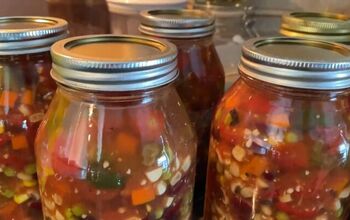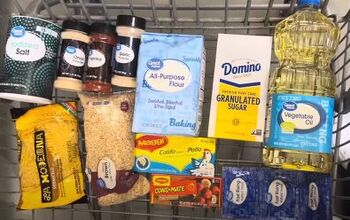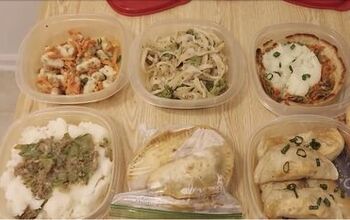How We Stick to a Grocery Budget of $130 a Week

(First written in 2014. Our current grocery budget in 2017 is around $160 a week. Ok, it’s 2022 now, and inflation is high. Our current budget is around $200, but I try to keep it down at $180 per week. The tips help keep your grocery budget as low as possible for your circumstances.)
Slash your weekly grocery budget, feed the family on $200 or less each week without eating rice and beans every night – can it be done?
Can it be done at Aussie prices?
Can you still enjoy things like smoked salmon, brie cheese and 70% dark chocolate?
The answer is yes, yes, yes!
Our average grocery spend each week is around $130 per week (2014). Some weeks it’s more; some weeks, it’s less, but it averages out at $130.
To give you a little context, we’re a family of four with two kids: 4 years old and two years old.
And while we’re not feeding hungry teenage boys (yet), there are times when the kids eat and eat (and eat and eat and eat…).
And that $130 covers food, cleaning, laundry, nighttime nappies…the lot!
I’m not saying anyone should stick to a grocery budget that’s as low as possible. $130 a week is just what we can afford at the moment.
If you buy all organics, or you have voracious teenagers, or you have allergies that need speciality foods, or you’re a family of 10, then your grocery budget is going to be more.
And that’s ok.
The most important thing to aim for is not to spend as little as possible but to buy the best quality groceries that you can afford on your budget.
Buy the best quality groceries that you can afford on your budget.
No more, no less.
Set your budget and work your grocery shop around that. Here are some tips to help you stay within your budget.
12 Ways we Save on Our Weekly Grocery Budget
1. MENU PLAN
Men planning is the foundation on which all other grocery savings are built on. You can shop less, avoid waste, bulk-buy specials, etc. when you plan ahead.
For the more information on how to menu plan, check out the article: how to menu plan easily.
2. SHOP LESS AND STICK TO YOUR LIST
Studies have shown that the more times you go to the store, the more likely you are to come back with impulse buys.
Impulse buys add up. What’s worse, if you haven’t got a plan for how to use those impulse buys, they can go to waste.
If you shop once a fortnight and stick to the grocery list, you created while menu planning, you reduce the temptation to impulse buy.
And when you’re bored and looking for something to do, don’t window shop. Go to the library, go for a hike, go for a swim, meet with a friend, enjoy a hobby instead of shopping.
3. WASTE LESS
Food waste is one of the biggest grocery expense for the average Aussie household. Up to 30% of what we buy goes in the bin. If you spend $200 a week on groceries, that adds up to $3,120 a year straight in the bin.
Save money by only buying what you need and eating what you buy.
Freeze food so that it doesn’t go bad. Use up leftovers. Make stock from the bones.
(Read further: Frugal kitchen hacks that reduce waste).
4. EAT LESS MEAT
If you’re vegan or vegetarian, you’ve got this one covered.
For the cavemen and women among us, this can be a hard tip to swallow.
If it’s any consolation, there’s some evidence that eating lots of meat isn’t all that healthy after all.
What is super healthy is the bones, marrow, cartridge, liver, kidneys, heart, hoofs, blood etc.. These parts of the animal just happen to be cheap as well.
(See: How to Eat Nose to Tail, Even if it Grosses You Ou t)
To save on meat, we eat small portions of meat, eat chicken, buy the cheaper cuts, have regular meat-free meals and extend the meat we do eat with lots of plant-based protein like veggies and beans, lentils and whole grains.
We buy kangaroo from the supermarket, grass-fed mince and beef and a free-range chook and chicken pieces from Aldi and lamb and pork from the wholesaler.
5. AVOID BREAKFAST CEREALS
Breakfast cereal costs a bomb. I’m always shocked at the price of cereals.
Not only are they expensive, but they’re also full of sugar as well.
Instead in our house, we eat porridge (cooked in the thermal cooker or slow cooker – super easy) with yoghurt, almonds and seasonal fruit; soaked oats or bircher muesli; eggs on toast with mushrooms, tomato and spinach; breakfast burritos with bacon, eggs, mushrooms, rocket and BBQ sauce or pancakes.
Breakfast takes a little more time and effort than cereal, but not much, especially porridge or muesli days.
6. SHOP AT ALDI
We’ve just started shopping at Aldi and I’ve seen some significant savings, although we’ve used some of those savings to invest in better quality food.
Aldi’s organic yoghurt and free-range eggs are super cheap as well as their organic wholemeal pasta and gluten-free flours.
If you avoid all the packaged foods and look for the good stuff, you can eat well and save money at Aldi.
7. BUY HOME BRAND
While Aldi is cheap, they don’t sell everything we would get in a normal shop and sometimes home brand is cheaper.
For basics like flour or toilet paper, you can’t beat home brand prices. The quality is similar to the big brands without the price.
8. BUY SPECIALS IN BULK
Bulk buying specials means you never pay full price. It will take a little bit of organisation and a little bit of extra money upfront, but in the long run, you save.
{Read further: Stockpiling food will save you money }
9. MAKE YOUR OWN CLEANERS
Vinegar and bicarb soda are super cheap, non-toxic and will leave your house sparkling from top to bottom.
No need to buy dozens of expensive chemical cleaners or even laundry detergent, making your own cleaners is simple and will save you a packet every year.
{Read further: Cleaning archive}
10. Avoid DISPOSABLES
Disposables add up because you have to buy them over and over.
There are viable alternatives to paper towel, cling wrap, napkins, dishcloths, wipes, nappies and even feminine hygiene products (better than disposables!).
Cut out a large chunk of your grocery budget and reduce your environmental impact by switching to reusables.
11. SHOP OUTSIDE THE SUPERMARKET
For fruit and veg, we visit a local greengrocer or go to the farmer’s markets because it’s a lot cheaper and better quality than the supermarkets.
Depending on the time of year, a massive box of fruit and veg usually costs us between $40 and $70 for the fortnight, Spring being the most expensive time, Autumn the least expensive. I might top it up with more lettuce and bananas later in the fortnight, but otherwise, that box is it.
This fortnight I spent $78, but I purchased 4kg of strawberries at $4 a kilo to make jam and to freeze some strawberries for when they’re out of season. I also bought a kilo of almonds and a kilo of local honey, both of which will last at least a month or two.
For more information, here are some tips on comparison shopping.
12. MAKE YOUR OWN
At $4 a kilo for strawberries, I can make about 2 large and 1 small jar of jam. The sugar and lemon are around another $1 so that’s about $1.70 a jar. Much cheaper than supermarket jam and I use a lot less sugar.
Whatever you can practically make yourself, be it muffins for the lunchbox, jam, bread, yoghurt, pizza sauce etc. will save you money.
You don’t need to go all out if you don’t have time (I don’t!). I still buy a packet of Arnott’s Family Assorted bickies for days when I just can’t or don’t want to bake. It’s all about saving where you can while still prioritising your time.
You may notice I haven’t included growing your own food here. While we do grow some things, particularly herbs, they supplement our grocery shop without making a huge impact on it.
You don’t have to grow your own food to slash your grocery bill, but if you do grow your own fruit and vegetables or keep your own chickens you can significantly reduce your grocery budget even further.
A huge weekly grocery bill each week doesn’t have to be a given. You can feed the family well on a tight budget by employing some of the grocery-saving tactics above.
What are your tips for saving money on the groceries?






















Comments
Join the conversation
Thank you for sharing your family’s best practices! Our family is trying to reduce the amount of disposable products in our home as well. We want to have less plastic waste/use. We also have increased the vegetable garden to get the most we can in the short growing season here in Minnesota. Thank you!
Sorry lost interest after I saw the gross part about Eat Less Meat and didn’t finish article.